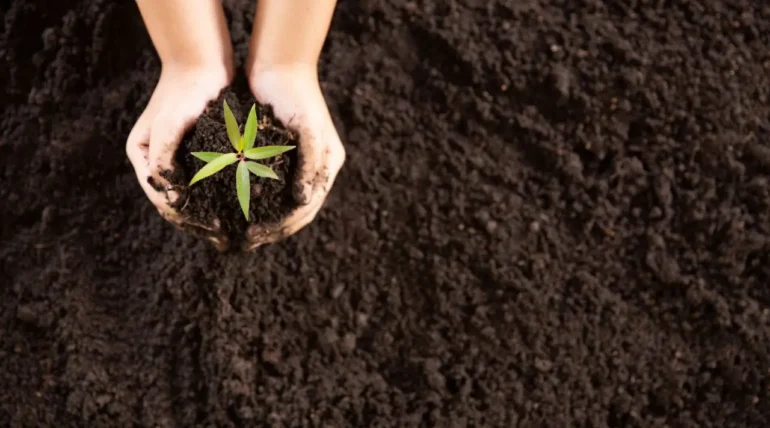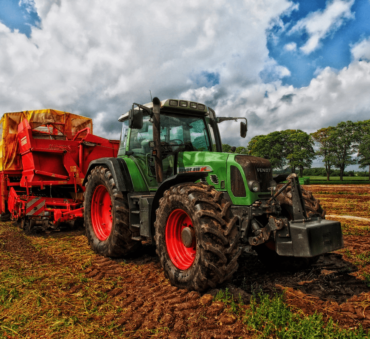Biochar vs. charcoal: Aren’t they the same?
Well, not exactly. While biochar and charcoal are both carbon-rich substances, they’re fundamentally different, each with their own applications, source materials, and physical properties.
Whether you’re a farmer, sustainability officer, waste management professional, or simply curious about this topic, understanding the differences between these materials is key to recognizing their distinct uses and environmental impacts.
So if you want to know the real difference between biochar and charcoal, keep reading.
Key Takeaways
- Biochar supports soil health, improves crop productivity, and helps fight climate change through long-term carbon sequestration; charcoal is primarily used as a fuel for cooking, heating, and manufacturing.
- A common feedstock for biochar is biomass, a renewable organic material derived from plants and animals; charcoal feedstock is typically wood, with hardwood varieties like oak, maple, hickory, and mesquite widely used.
- Biochar is carbon-rich, highly porous, and stable, making it useful for environmental remediation; charcoal, produced at lower temperatures, is less porous, less stable, and breaks down in soil more quickly.
What is Biochar?
Biochar is a fine-grained, highly porous material that is made from biomass such as agricultural byproducts, forestry residues, and solid waste. There are multiple benefits of biochar to the environment, such as improving soil carbon sequestration, enhancing soil health, and promoting a circular economy.
Unlike charcoal, biochar is primarily produced for agricultural and environmental applications rather than as a fuel source.
What is Charcoal?
Charcoal is a hard black material that’s made by heating wood or other organic materials in a low-oxygen environment. Charcoal is the principal wood fuel in urban areas of many less developed countries, as it has higher energy density, burns cleaner, and is easier to transport, handle, and store than wood.
Activated Charcoal vs. Horticultural Charcoal
Before we dive into the key differences between biochar and charcoal, there’s another topic we should discuss: horticultural charcoal vs. activated charcoal.
1. Activated Charcoal
ScienceDirect defines activated carbon as “a form of char that is derived from charcoal or biochar through a physical or chemical activation process, characterized by enhanced physicochemical properties such as large surface area and high porosity, making it effective for applications in sorption and pollutant remediation.”
Activated carbon is usually made by heating organic materials at high temperatures without oxygen and then ‘activating’ them to create a porous structure. Because of this additional processing, it’s typically more expensive—and more versatile—than horticultural charcoal.
It’s no secret that activated charcoal has an array of environmental benefits. It helps combat air, water, and soil pollution, and studies show it is an effective adsorbent for wastewater treatment and air purification. It’s also known for being beneficial to plants and microbes for removing toxic organic pollutants during soil remediation.
2. Horticultural Charcoal
Horticultural charcoal, or inactive carbon, is a type of charcoal used in gardening that improves soil aeration, drainage, and odor control. But did you know that many people use the terms “horticultural charcoal” and “biochar” interchangeably?
While it’s not uncommon to confuse these terms, they still have minor differences. Horticultural charcoal is a type of biochar, but unlike biochar’s wide range of applications, it’s mainly produced and marketed for gardening and agricultural use.
Since it’s typically fired without chemicals, it’s also the more affordable option, making it especially appealing in agricultural and gardening contexts where cost-effectiveness matters.
Biochar vs. Charcoal: Key Differences
So what’s the difference between biochar and charcoal?
Below, we compare how they differ in applications, production processes, physical properties, and more.
| Key Differences | Biochar | Charcoal |
|---|---|---|
| Application | Because of its many environmental benefits, there are multiple ways biochar is used in agriculture and farming | The primary application of charcoal is as fuel for cooking, heating, and manufacturing. |
| Production Process | The most common method of biochar production is pyrolysis, a thermochemical process that decomposes organic materials, such as biomass or waste, in the absence of oxygen. | Charcoal is also produced through pyrolysis. However, the process is different, as it typically heats wood or organic waste at lower temperatures |
| Source materials | A common feedstock of biochar is biomass, a renewable organic material that comes from plants and animals. | Wood is the primary feedstock for charcoal, with hardwood varieties like oak, maple, hickory, and mesquite widely used. |
| Physical properties | Biochar is a carbon-rich substance with greater porosity and surface area than charcoal. | Charcoal is less porous than biochar and represents a less stable form of carbon, causing it to break down in soil more quickly. |
| Chemical properties | Biochar exhibits high biodegradability, high contents of total and organic carbon, and optimal concentrations of micro- and macroelements (such as potassium, sodium, magnesium, calcium, copper, zinc, and iron). | Charcoal contains very little moisture—usually less than 1%, though it can rise to 5–10% depending on air humidity. |
1. Applications
Biochar: Because of its many environmental benefits, there are multiple ways biochar is used in agriculture and farming. It supports soil health, improves crop productivity, reduces the need for chemical fertilizers, and fights climate change by contributing to long-term carbon sequestration. In sustainable farming, farmers use biochar through methods like seed coating, fertilizer blending, and broadcasting.
Charcoal: The primary application of charcoal is as fuel for cooking, heating, and manufacturing. Its role as a vital energy source is especially significant in developing regions; for instance, more than 80% of urban households in sub-Saharan Africa use charcoal as their main source of cooking energy.
Activated charcoal also has medical applications, such as treating cases of poisoning or overdose.
2. Production Process
Biochar: The most common method of biochar production is pyrolysis, a thermochemical process that decomposes organic materials, such as biomass or waste, in the absence of oxygen. Biochar is typically produced at high temperatures to increase its carbon content, allowing it to remain stable in the soil for extended periods.
Charcoal: Charcoal is also produced through pyrolysis. However, the process is different, as it typically heats wood or organic waste at lower temperatures. While charcoal production is generally considered simple, the type of wood used, heating temperature, air availability, and processing time all influence the yield and properties of the final product.
3. Source materials
Biochar: A common feedstock of biochar is biomass, a renewable organic material that comes from plants and animals. There are various biomass waste materials appropriate for biochar production, including crop residues, yard, food, and forestry wastes, and animal manures, making it a great solution for farm waste management.
Charcoal: Wood is the primary feedstock for charcoal, with hardwood varieties like oak, maple, hickory, and mesquite widely used. Other organic materials can also serve as feedstock, including coconut shells, rice husks, bamboo, and agricultural waste.
4. Physical properties
Biochar: Biochar is a carbon-rich substance with greater porosity and surface area than charcoal. These properties, along with its abundance of functional groups, make it an appealing choice for environmental remediation.
Charcoal: While also a carbon-based material, charcoal has different physical properties because of how it’s produced. Manufactured at lower temperatures, it’s less porous than biochar and represents a less stable form of carbon, causing it to break down in soil more quickly.
It’s important to note that the physical properties of both biochar and charcoal are largely influenced by the type of feedstock used during production.
5. Chemical properties
Biochar: Biochar exhibits high biodegradability, high contents of total and organic carbon, and optimal concentrations of micro- and macroelements (such as potassium, sodium, magnesium, calcium, copper, zinc, and iron). However, like physical properties, the chemical properties also vary depending on the feedstock and pyrolysis temperature.
High pyrolysis temperatures produce biochar with greater surface area, higher porosity, higher pH, and increased ash and carbon content, while reducing its cation exchange capacity and volatile matter.
Charcoal: Charcoal contains very little moisture—usually less than 1%, though it can rise to 5–10% depending on air humidity. Its volatile matter content can vary from over 40% to below 5%. Why does this matter?
Because high-volatile charcoal is easy to ignite but may burn with a smoke flame, while low-volatile charcoal is difficult to light and burns very cleanly. This directly affects how charcoal performs as a fuel.
6. Activation
Biochar: There are several ways to charge biochar with nutrients and microbes before applying it to soil, such as mixing it with compost.
As described by SciencDirect, “Physical activation and chemical activation are the main methods applied in the activation process. These methods could have significantly beneficial effects on biochar chemical/physical properties, which make it suitable for multiple applications including water pollution treatment, CO2 capture, and energy storage.”
Charcoal: Activated Charcoal is carbon that has been treated to create small, low-volume pores that increase the surface area available for adsorption. Processes such as steam and chemical activation expose charcoal to various substances and conditions that alter its properties. As a result, it becomes more effective at adsorbing a wide range of toxins and pollutants.
How Biochar Supports Shapiro’s Commitment to Sustainable Agriculture
Our team at Shapiro has an array of farm and agricultural waste solutions, including innovative approaches like biochar that turn waste into long-term value for both farmers and the environment.
We handle everything from feedstock identification to collection and pre-processing, ensuring you stay compliant while reducing your environmental impact.
And since biochar production is a new topic for many companies, we offer valuable guidance in everything you need, answering questions like: Is carbon the same as charcoal? What’s the difference between vegetable charcoal vs. activated charcoal?
With our services, you can better understand the role of biochar in sustainable agriculture and take advantage of its benefits.
Conclusion
Now that we’ve settled the debate between biochar vs. charcoal, we can better understand how biochar fits into sustainable practices.
As an experienced food waste recycling company, we create tailored waste management solutions that meet the unique needs of your business. Whether you’re looking for a biochar company, a composting partner, or another waste management solution, we’re here to support you every step of the way.
Contact us today to learn more about our services.
FAQs about Biochar vs. Charcoal
No, charcoal should not be used to replace biochar, as they have different structural properties. However, some gardeners use horticultural charcoal substitute, which is produced for agricultural use to improve soil aeration, drainage, and odor control.
Yes, biochar is safe for organic farming, as it’s made from natural biomass and can improve soil health while reducing the need for chemical fertilizers.
If not properly managed, charcoal produced from trees can lead to deforestation, compromise biodiversity, and increase pollution and greenhouse gas emissions, thereby amplifying climate change and adversely impacting human health.
Yes, biochar can help farmers adapt to climate change by enhancing soil health, boosting water retention, and improving soil carbon sequestration.
Baily Ramsey, an accomplished marketing specialist, brings a unique blend of anthropological insight and marketing finesse to the digital landscape. Specializing in educational content creation, she creates content for various industries, with a particular interest in environmental initiatives.



